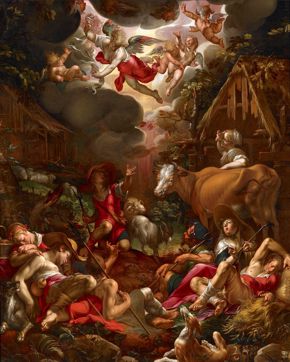Keeping Watch over Their Flocks: Joachim Wtewael’s Shepherds December 9, 2015

Joachim Wtewael, The Annunciation to the Shepherds, 1606, oil on canvas, Sarah Campbell Blaffer Foundation, Houston.
You’ll see shepherds throughout the exhibition Pleasure and Piety: The Art of Joachim Wtewael (1566–1638) because pastoral imagery—that is, depictions of shepherds and serene countrysides—was common in early-17th-century painting and literature. Joachim Wtewael’s shepherds, clean and idealized, carry the accoutrements of the pastoral life: a water-filled gourd, bagpipes, floppy hats, and a staff with a cupped end for tossing rocks to help herd the sheep. Some shepherds wear tops that bare a single shoulder, not unlike shirts that were briefly fashionable for the über-stylish man of 2014.
Two compositions in the exhibition tell the story of Christmas through the eyes of shepherds. The Annunciation to the Shepherds refers to the Gospel of Luke, which describes an angel appearing to shepherds at night to tell them a savior is born. The shepherds were terrified, as one would be. But Wtewael’s shepherds are more bewildered than terrified; in fact, several are still asleep, and the range of reactions to the angel’s appearance may be a metaphor for the range of people’s reactions to the divine.
The shepherds take the angel’s message to heart and hasten to see the child lying in a manger, which Wtewael shows in the painting hanging nearby: The Adoration of the Shepherds.

Joachim Wtewael, The Adoration of the Shepherds, 1598, oil on canvas, Collection Centraal Museum Utrecht, purchase with support from Rembrandt Society.
Most of the shepherds gather around the baby who will soon be called Jesus, as one stands with a lamb on his shoulder, recalling biblical depictions of Christ as the Good Shepherd who is willing to lay down his life for his sheep (John 10:11). The shepherds in these paintings represent ideals of humility, faith, sacrifice, and peace.
In addition to the paintings depicting the story of Christmas, matching half-length depictions of a shepherdess and a shepherd (which may portray one of Wtewael’s daughters and her future husband) hang nearby:


Joachim Wtewael, A Shepherdess and A Shepherd, 1623, oil on panel, Harvard Art Museums/Fogg Museum, Melvin R. Seiden Purchase Fund in honor of William W. Robinson.
And there are mythological shepherds, too: In one painting, a shepherd from Apulia, Italy, comes across a group of dancing nymphs in the woods—a not uncommon occurrence back in the day, one might imagine. As the ancient Roman poet Ovid wrote in Metamorphoses, the shepherd mocked the nymphs by “leaping clumsily about in imitation, hurling coarse insults as well, and abusing them in foul language.” Big mistake! They turned him into an olive tree—surely, a lesson for all of us.

Joachim Wtewael, The Apulian Shepherd, c. 1600–1605, oil on copper, Rose-Marie and Eijk van Otterloo Collection.
The shepherd Paris was really a prince of Troy but was raised by shepherds. He was appointed by Jupiter to judge which goddess was the most beautiful: Venus, Minerva, or Juno. Paris chose Venus because she had promised him the most beautiful woman in the world, Helen of Sparta. He took Helen back to Troy, which did not please her husband, King Menelaus. The result was the decade-long Trojan War. These things happen.

Joachim Wtewael, The Judgment of Paris, 1615, oil on panel, the National Gallery, London, bequeathed by Claude Dickason Rotch.
► See “Pleasure and Piety” in the Beck Building through January 31, for free with general admission.





